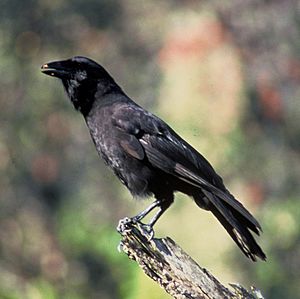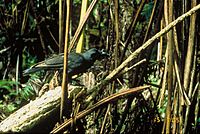Hawaiian crow facts for kids
Quick facts for kids Hawaiian crow |
|
|---|---|
 |
|
| Conservation status | |
| Scientific classification | |
| Genus: |
Corvus
|
| Species: |
hawaiiensis
|
 |
|
| Geographic region: Hawaiian Islands | |
The Hawaiian crow, also known as the ʻAlalā (Corvus hawaiiensis), is a special bird from the crow family. Sadly, it is now extinct in the wild, meaning you can't find it living freely in nature anymore. But don't worry, people are working hard to bring it back!
This crow is about 48 to 50 centimeters (19-20 inches) long, similar to a carrion crow. It has soft, brownish-black feathers and a thick beak. Its wings are more rounded than other crows, and its feet, legs, and beak are black. Today, the Hawaiian crow is the most endangered bird in the crow family. They can live up to 18 years in the wild and 28 years in zoos. Some Native Hawaiians believe the Hawaiian crow is an ʻaumakua, which is like a family spirit or god.
The ʻAlalā is known for being a strong flyer and very clever. Scientists are still trying to fully understand why it disappeared from the wild. It's thought that diseases like Toxoplasma gondii, avian malaria, and fowlpox played a big part in its decline.
Contents
Where the Hawaiian Crow Lived
Before the Hawaiian crow disappeared from the wild, it was only found in the western and southeastern parts of Hawaii. It lived in dry and moist forests on the slopes of Mauna Loa and Hualālai mountains. These areas were between 3,000 and 6,000 feet high.
Important trees in its home included Ōhiʻa lehua and koa trees. The crow needed lots of plants and bushes on the forest floor to hide from predators like the Hawaiian Hawk, also called ʻio. The places where the ʻAlalā built its nests received about 600 to 2500 mm (24-98 inches) of rain each year. Old fossils show that the Hawaiian crow used to be quite common on all the main Hawaiian islands, along with four other crow species that are now extinct.
The Hawaiian crow was also hunted by rats and small Asian mongooses. Feral cats, which brought the Toxoplasma gondii disease to the birds, could also hunt young chicks that couldn't fly yet. As of 2012, there were 114 Hawaiian crows, mostly living in special reserves in Hawaii.
Hawaiian Crow Behavior
What the Hawaiian Crow Eats
The Hawaiian crow is an omnivore, meaning it eats both plants and animals. It's a generalist, so it eats many different foods depending on what's available. About half of their feeding time is spent looking for invertebrates like isopods, land snails, and arachnids on tree trunks, branches, and leaves.
They often act like woodpeckers, pulling off bark and moss to find hidden insects. They mostly search on ohia and koa trees, which are the tallest trees in their habitat. Fruits are the second most important part of their diet. Crows often gather clusters of kepau and olapa fruits. Even if fruits like hoawa and alani have hard shells, crows work hard to open them.
Young birds and eggs from other songbirds are eaten most often in April and May, during the crow's breeding season. Other birds they might eat include the red-billed leiothrix, Japanese white-eye, Hawaiʻi ʻamakihi, ʻIʻiwi, ‘elepaio, and ʻapapane. The ʻAlalā also eats flowers, especially from February to May. They get nectar from ohia, oha kepau, and purple poka flowers to feed their young. Crows also eat parts of plants, like the flower petals of kolea, koa, and mamane. The palila is the only other Hawaiian bird known to eat flower petals. The ʻAlalā doesn't spend much time foraging on the ground because of the risk of predators.
Tool Use
Hawaiian crows in captivity can use sticks as tools. They use them to get food out of holes drilled in logs. Young crows show this tool-using ability without any training or learning from adult crows. This suggests that using tools is a natural skill for all Hawaiian crows.
Voice
The Hawaiian crow has a unique call. Some people describe it as a two-toned caw. Others say it sounds like a screech with lower tones, similar to a cat's meow. When flying, this bird makes many different sounds, including a repeated "kerruk, kerruk" and a loud "kraa-a-a-ik." It also makes a "ca-wk" sound and has a complex, bubbly song.
Breeding and Reproduction
Female Hawaiian crows can start having babies when they are about 2 or 3 years old. Males are ready at about 4 years old. The Hawaiian crow's breeding season is from March to July. They build a nest in March or April and lay eggs in mid-to-late April. The eggs hatch in mid-May.
Both male and female crows build nests using branches from the native ohi’a tree, making them stronger with grasses. The crow usually lays one to five greenish-blue eggs per season. However, usually only one or two chicks survive past the stage where they can fly. Only the females sit on the eggs for 19–22 days to keep them warm. They also care for the young birds. Chicks usually leave the nest about 40 days after hatching. If the first set of eggs is lost, the pair will lay more eggs, which is helpful for breeding programs in zoos. Young crows depend on their parents for 8 months and stay with their family until the next breeding season.
Environmental Role
The ʻAlalā was one of the largest native bird populations in Hawaii. Its disappearance from the wild has caused big problems for the environment. This is especially true for how native plants spread their seeds. Many of these plants rely on the ʻAlalā not only to carry their seeds but also for the seeds to sprout. This happens when the seeds pass through the crow's digestive system. Without the crow to spread seeds, these plants have no way to grow new generations.
The ʻAlalā plays a key role in keeping many native plant species healthy. Without their main seed disperser, these plants could become rare in Hawaii's ecosystems, especially in the dry forests. The Hawaiian crow has become known as an indicator species. This means that the disappearance of the ʻAlalā shows there are serious environmental problems.
Main Threats to the Hawaiian Crow
The Hawaiian crow faces many dangers in the wild, which are believed to have caused its extinction there. Having a small population makes the species more vulnerable to changes in the environment. It also leads to more inbreeding, which can cause serious health problems.
Unlike most crows, Hawaiian crows did not adapt well to humans. People sometimes harmed the ʻAlalā because they thought the birds disturbed their crops. Illegal hunting continued even after laws were made to protect the crows. Humans have also damaged and destroyed the crow's habitat by clearing land for farming, ranching, and logging. Non-native animals like wild pigs and goats also harm the forests.
Losing the tree cover exposes the ʻAlalā to dangerous predators. Chicks are vulnerable to tree-climbing rats. After they leave their nests, they can be hunted by cats, dogs, and mongooses. Cutting down trees also increases soil erosion and helps invasive plants and mosquitoes spread. This directly relates to the main reason for the Hawaiian crow's extinction: disease.
Avian Malaria
Avian malaria is a disease that affects birds. It is caused by a tiny parasite called Plasmodium relictum. This parasite affects birds all over the world. Usually, this disease doesn't kill birds. However, in isolated places like Hawaii, birds have lost their natural ability to fight off new diseases. So, they can't defend themselves against this new parasite.
The main carrier of avian malaria is the mosquito Culex quinquefasciatus. This mosquito was brought to the Hawaiian islands in 1826. This happened partly because bird clubs brought non-native bird species to replace birds that died from another disease called Avipoxvirus. At least 100 times, new species were brought in this way.
Status and Conservation
The Hawaiian crow is the most endangered crow species in the world. It is the only crow species left in Hawaii. Like other critically endangered species, it is illegal to harm the Hawaiian crow under U.S. federal law. By 1994, the population had dropped to only 31 birds. Only 8 to 12 were in the wild, and 19 were in zoos. The last two known wild Hawaiian crows disappeared in 2002. Because of this, the species is now listed as Extinct in the Wild by the IUCN Red List.
As of August 2014, about 115 Hawaiian crows live in two captive breeding facilities run by the San Diego Zoo. However, attempts to release these birds back into the wild have been difficult. This is mainly because of predators like the Hawaiian hawk, which is itself listed as Near Threatened. Breeding efforts have also been complicated because of a lot of inbreeding during the crow's population decline.
Protection
The ʻAlalā has been legally protected by the state of Hawaii since 1931. It was recognized as federally endangered in 1967. Since the 1990s, areas on the slopes of Mauna Loa and other natural ranges have been set aside to rebuild their habitat and help native birds recover. The Kūlani Keauhou area has been chosen as the best spot for the crows. Parts of this area have been fenced off and kept free of wild animals like pigs for 20 years. This has greatly helped the habitat recover.
Reintroduction Efforts
Programs to bring back the Hawaiian crow need many groups to work together. These include private landowners, biologists from the National Biological Service (NBS), biologists from the US Fish and Wildlife Service, and the State of Hawaii. In 1993 and 1994, 17 eggs were taken from wild nests and moved to a temporary hatching center in Kona District, Hawaii. Puppets that looked like adult crows were used to feed the chicks. This was done to make sure the chicks didn't get too used to humans. Three of the eggs were not fertile, 13 chicks hatched, and 12 ʻAlalā were successfully raised. One egg didn't hatch because the baby bird was in the wrong position, and another chick died from an infection.
In December 2016, five young male Hawaiian crows were released into the Pu'u Maka'ala Natural Area Reserve on the Big Island. This was the first time these birds had been in the wild since 2002. However, within a week, three of the five birds were found dead. Two died because of the Hawaiian hawk, and the other died from starvation. The remaining two crows were taken out of the wild.
On September 26, 2017, six more crows were released into the Pu'u Maka'ala Reserve. This group had four males and two females, unlike the previous release which only had males. On October 11, 2017, another group of five crows (three males and two females) was also released there. The first group released also formed social groups, just like wild crows would. They also reacted to dangers in their environment, showing they were aware of their surroundings. As of 2018, they were described as "thriving." However, they might have been negatively affected by the 2018 lower Puna eruption, which damaged at least a third of the Malama Kī Forest Reserve. This reserve is an important home for the Hawaiian crow and other endangered Hawaiian wildlife. After the success of the previous year's release, another five crows were reintroduced to the Pu'u Maka'ala Reserve on September 25, 2018. In late 2018, one of the crows released in 2017, a male named Maka'ala, was found dead. It likely died from wounds from a predator attack, followed by other animals eating it.
In May 2019, two of the released crows, Mana’olana and Manaiakalani, were seen building a nest. The female was sitting on eggs. This was the first time Hawaiian crows had tried to breed in the wild since they became extinct there. However, the eggs never hatched and were thought to be infertile. But it's not uncommon for this species to lay eggs that don't hatch sometimes.
Breeding Efforts in Zoos
To try and save the ʻAlalā, efforts have been made to breed the species in zoos. Most of these efforts have not been very successful. Studies have shown that female crows are the main nest builders. If the male stays around the nest for too long and tries to sit in it, the female might stop building. Or, in other cases, the male and female might become aggressive towards each other. This kind of behavior can stop them from laying eggs.
On average, the number of eggs laid in zoos is much lower than what has been seen in the wild. This can be because of thin eggshells from inbreeding and behavioral problems from the males. When raised alone, some male crows act aggressively towards their mates and don't understand friendly gestures. For the best breeding success, it's important for their cages to feel like a real environment. Also, males who have been raised with other crows should be put with females.
Conservation Plans
On April 16, 2009, the U.S. Fish and Wildlife Service announced a five-year plan. They planned to spend over $14 million to stop the Hawaiian crow from becoming completely extinct. This plan included protecting their homes and managing threats to the species.
Cultural Importance
The Hawaiian crow is also a very important symbol in Hawaiian mythology. It is said to guide souls to their final resting place on the cliffs of Ka Lae, the southernmost tip of the Big Island of Hawaii. Native priests would mention the ʻAlalā during prayers and chants because of its special call.
See also
In Spanish: Cuervo hawaiano para niños




